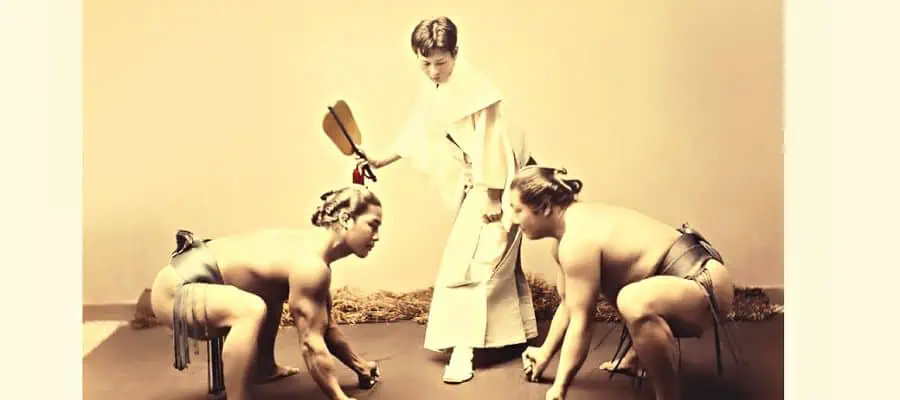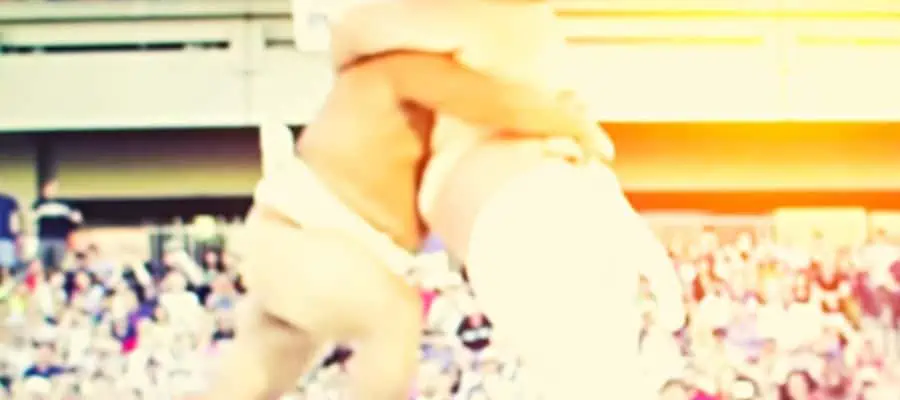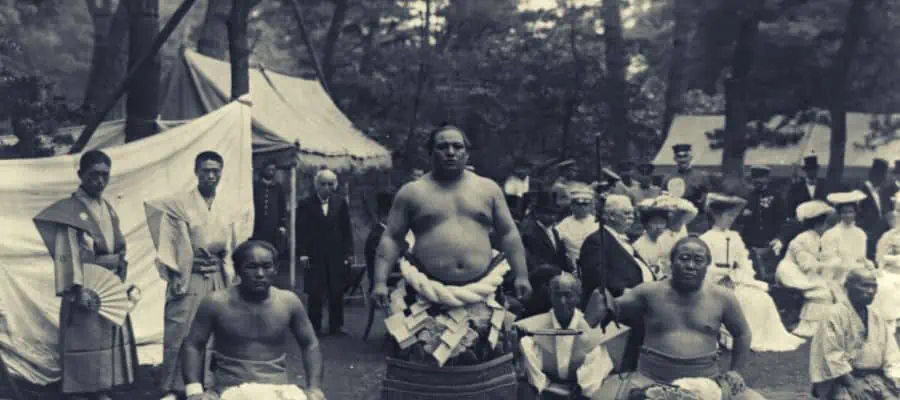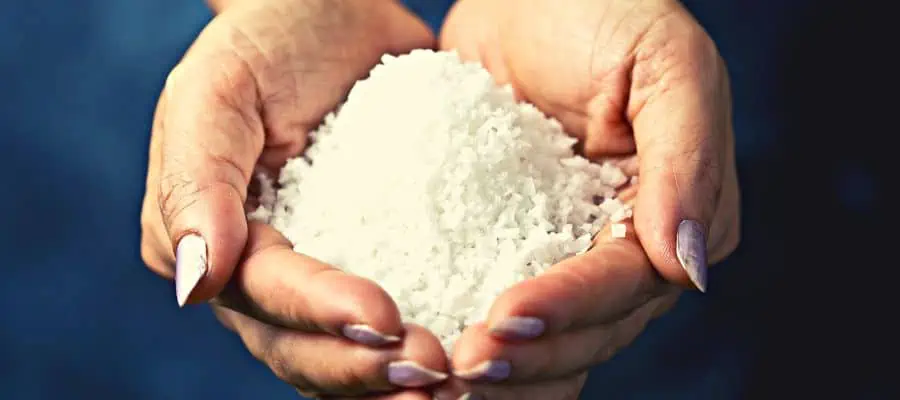Sumo wrestling, an ancient Japanese sport steeped in tradition and culture, has long captivated the imagination of audiences worldwide.
But is Sumo merely a competitive pastime, or does it qualify as a martial art in its own right? In General, Sumo wrestling is a martial art. It has unique techniques, training, and traditions but focuses on physical combat and self-discipline, like other martial arts. Sumo is special because of its emphasis on size, strength, and Japanese culture.
Sumo wrestling, a strength contest for ancient Japanese warriors, has since evolved into a ceremonial sport with specific techniques and strategies and even incorporates Shinto rituals. The modern form of sport has been standardized and formalized through professional organizations such as the Japan Sumo Association. It has gained international popularity in recent years. By exploring Sumo’s techniques and principles, one can truly appreciate the depth and intricacies of this fascinating martial art.
Is Sumo Wrestling A Martial Art?

Sumo wrestling is considered a martial art. It is a traditional Japanese sport emphasizing size, strength, balance, and technique. While sumo may not involve striking or kicking techniques commonly associated with other martial arts, it shares many characteristics that qualify it as a martial art, such as focusing on physical combat, self-discipline, and spiritual growth.
Sumo wrestling also shares philosophical tenets with other martial arts, such as pursuing personal excellence, self-improvement, and developing mental fortitude. Its deep ties to Japanese culture and history further underscore its martial arts credentials, with its rituals and traditions adding complexity and meaning to the sport.
In terms of technique, sumo has its own unique set of movements and strategies that distinguish it from other martial arts, such as the “Four Pillars” of “yotsu-sumo,” “oshi-sumo,” “nage-sumo,” and “hiki-sumo.” These techniques involve a combination of grappling, pushing, pulling, and throwing to force opponents out of the ring or to the ground.
Furthermore, sumo wrestlers engage in rigorous training, including specialized exercises, practice matches, and traditional strength training, all of which help them develop their physical and mental capabilities. They also live and train together in specialized facilities called sumo stables, where they adhere to strict daily routines that encompass not only training but also communal living, chores, and adherence to traditional customs.
Stable In Sumo Wrestling
Sumo wrestlers typically live and train together in specialized facilities called sumo stables or “heya.” These stables are run by retired sumo wrestlers who have taken on the role of stablemaster, guiding the next generation of wrestlers in their development. Life in a sumo stable is highly regimented, with strict daily routines encompassing not only training but also communal living, chores, and adherence to traditional customs.
Physical Conditioning
Sumo wrestlers engage in intense daily training sessions designed to build strength, speed, flexibility, and endurance. Training exercises include shiko (leg-stomping), matawari (side-split stretches), and suriashi (sliding feet practice).
Wrestlers also engage in practice matches called “keiko,” where they apply and refine their techniques under the watchful eye of their stablemaster. In addition to these specific sumo exercises, wrestlers often participate in traditional strength training, such as lifting weights and performing bodyweight exercises like push-ups and squats.
The Philosophy And Spirituality Of Sumo Wrestling
Sumo wrestling is deeply intertwined with Japan’s indigenous Shinto religion. Many aspects of the sport are imbued with spiritual significance. The dohyo (ring) is considered a sacred space, with purification rituals performed before each match to cleanse the area and appease the gods.
Wrestlers also participate in pre-match rituals, such as the iconic leg-stomping shiko and the salt-throwing ceremony, which are believed to ward off evil spirits and ensure a fair and honorable contest. While sumo wrestling predates the emergence of the samurai class, it shares many philosophical tenets with the bushido code that guided Japan’s warrior caste.
Honor, loyalty, and self-discipline are central to both sumo and bushido, underscoring the martial spirit that permeates the sport. Sumo wrestlers strive for personal excellence in their physical abilities and conduct, reflecting the bushido ideal of the “complete warrior.”
At its core, sumo wrestling is a journey of self-discovery and self-improvement, with wrestlers constantly pushing themselves to reach new heights of skill and understanding. The path of a sumo wrestler is not solely about victory and accolades; it is also about the pursuit of personal growth, self-mastery, and spiritual enlightenment. This emphasis on self-betterment aligns sumo wrestling with other martial arts, where personal development is often the ultimate goal.
Mental Fortitude And Discipline
The rigorous training regime and strict lifestyle of sumo wrestlers require immense mental fortitude and self-discipline. Wrestlers must adhere to a strict hierarchy within the stable, with younger wrestlers serving their seniors and performing chores to maintain the facility.
This hierarchical structure instills a deep sense of humility, respect, and perseverance, fostering the mental toughness necessary to excel in the demanding world of professional sumo.
Comparing Sumo Wrestling To Other Martial Arts

While sumo wrestling shares some common ground with other martial arts regarding techniques, training, and philosophy, it is distinct in several ways. Sumo emphasizes size, strength, and balance, setting it apart from other martial arts that may prioritize speed, agility, or striking prowess.
The specific techniques and strategies in sumo are tailored to the sport’s objective: to force the opponent out of the ring or to the ground, creating a unique set of movements and tactics. Sumo’s deep ties to Japanese culture and tradition further differentiate it from other martial arts, with its rituals and customs adding an additional layer of complexity to the sport.
Sumo’s Unique Traits And Characteristics
The distinctive features of sumo wrestling include its emphasis on size and weight, which contrasts with the weight classes seen in many other martial arts. The mawashi (belt) is another unique element, serving as both the wrestler’s uniform and a key component of many sumo techniques. The dohyo (ring) is another distinctive aspect.
Unlike the rectangular or octagonal spaces used in other combat sports, it is a circular area with a specific size and construction. The specific rules governing victory and defeat, such as the prohibition of certain moves and the importance of remaining within the ring, also set the sumo apart from other martial arts.
Overlapping Techniques
Despite its unique characteristics, sumo wrestling shares some techniques with other martial arts, particularly those that focus on grappling, throwing, and joint manipulation. For example, judo and Brazilian jiu-jitsu practitioners may find similarities in the throwing techniques used in sumo.
For example, the “uwatenage” (overarm throw) or “shitatenage” (underarm throw), which resemble certain judo throws like “harai goshi” or “uchi mata.” Similarly, Greco-Roman wrestlers might recognize familiar clinch work and upper-body grappling in sumo, as both sports emphasize control and leverage to defeat opponents.
In comparing sumo to wrestling, there are notable parallels and distinctions. Both sports involve grappling and the goal of taking down the opponent, but sumo wrestlers rely more on pushing and shoving techniques. In contrast, wrestlers in other styles often focus on takedowns, pins, and submissions.
Furthermore, sumo wrestlers wear the mawashi, whereas other wrestlers typically wear singlets or shorts. The dohyo in sumo is also unique compared to the wrestling mats used in other styles. Additionally, sumo wrestling has a strong cultural and historical foundation, with its rituals and traditions playing a significant role in each match.
This aspect is less prominent in many other wrestling styles, which may focus more on athletic competition than cultural expression. The hierarchical structure and communal living arrangements within sumo stables also set sumo wrestling apart from other wrestling disciplines, which generally do not involve such regimented living and training environments.
While sumo wrestling shares some commonalities with other martial arts and wrestling styles regarding techniques and objectives, it stands apart in various aspects, such as its unique emphasis on size, weight, and cultural traditions. By understanding these similarities and differences, we can better appreciate sumo wrestling as a captivating and distinct martial art in its own right.
How Do Sumo Wrestlers Fight?

Basic Techniques: The Four Pillars Of Sumo
There are four primary techniques in sumo wrestling, known as the “Four Pillars”: yotsu-sumo, oshi-sumo, nage-sumo, and hiki-sumo. Yotsu-sumo involves gripping the opponent’s belt (mawashi) to control their movement and eventually force them out of the ring or to the ground.
Oshi-sumo is characterized by powerful thrusts and slaps to push the opponent out of the ring. Nage-sumo uses throws and trips to topple the opponent. In contrast, hiki-sumo uses pulling techniques to unbalance and defeat the adversary.
In addition to the Four Pillars, sumo wrestlers employ various advanced techniques that capitalize on leverage and balance. These include leg sweeps, arm locks, and different lifting techniques, which enable smaller or less powerful wrestlers to defeat larger and stronger opponents. Mastering these advanced techniques requires years of dedicated practice and a deep understanding of the sport’s underlying principles.
Do Sumo Wrestlers Use Strategy?
While physical prowess is essential in sumo wrestling, mental acuity, and strategic thinking are equally important. Wrestlers must constantly adapt to their opponent’s movements, anticipating their actions and exploiting any weaknesses. A successful sumo wrestler is strong and possesses keen situational awareness, quick decision-making skills, and the ability to execute complex techniques under immense pressure.
How Much Do Sumo Wrestlers Eat In A Day?

Sumo wrestlers consume a specialized diet designed to provide them with the necessary energy and nutrients to maintain their massive size and fuel their intense training. The cornerstone of this diet is “chanko-nabe,” a stew made from various ingredients such as fish, meat, tofu, and vegetables, served with large quantities of rice.
Wrestlers typically eat two large meals daily, consuming up to 8,000-10,000 calories to support their energy demands and promote weight gain. And, of course, junk food isn’t off-limits either.
Rest And Recovery
Rest is a crucial aspect of a sumo wrestler’s lifestyle. After their morning training sessions, wrestlers take an extended nap to aid in recovery and facilitate weight gain. Adequate sleep is essential for physical and mental well-being, allowing wrestlers to perform at their peak during training and competition.
Does Sumo Have Weight Classes?

Sumo wrestlers are classified into divisions based on their weight. There are six divisions, with the heaviest and highest division being the makuuchi division and the lightest and lowest division being the jonokuchi division. The weight classifications are not determined by specific weight limits but rather by the wrestler’s rank within the sport.
The heaviest wrestlers in the highest division can weigh over 600 pounds. The lightest wrestlers in the lowest division typically weigh around 200 pounds. The sumo wrestler’s weight and size are significant factors in the sport, as the objective is to use size and strength to push or throw one’s opponent out of the ring.
Why Do Sumo Wrestlers Throw Salt Before The Match?

The salt-throwing ritual is an iconic part of sumo wrestling matches. Before each bout, the wrestlers enter the ring and perform pre-match rituals, including throwing salt onto the dohyo (ring). The salt-throwing is believed to have both practical and symbolic significance. On a practical level, the salt helps to purify the ring and prevent slipping.
Symbolically, the salt is meant to ward off evil spirits and create a sense of purity and sanctity within the ring. Throwing salt is also thought to represent the wrestler’s commitment to the match, as it symbolizes throwing away distractions and focusing solely on the upcoming bout.
Conclusion
By exploring the rich history, techniques, and philosophies that underpin sumo wrestling, it becomes clear that sumo is indeed a martial art in its own right. With its unique blend of strength, skill, and spiritual depth, sumo wrestling occupies a special place within the martial arts world. As the sport continues to evolve and adapt to the challenges of the modern world, it will undoubtedly maintain its status as a stunning and awe-inspiring martial art.
Recent Posts
What is Manachai's Fighting Style? Unveiling Muay Thai Mastery
Manachai, a celebrated figure in the Muay Thai world, has captivated audiences with his exemplary martial prowess. Hailing from the heartlands of Thailand, his name is synonymous with the art of...
What Was Chamuekpet Hapalang's Fighting Style? Unveiling Techniques
Chamuekpet Hapalang was a renowned figure in the world of Muay Thai (record 200-48-2), embodying a fusion of Muay Bouk and Muay Khao styles. Originating from Thailand, the art of Muay Thai is known...
